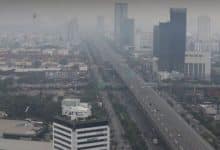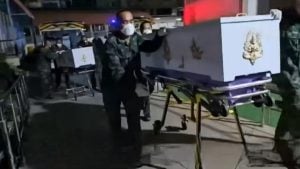Ultrafine dust blankets 50 Thai provinces posing serious health risks

Hazardous levels of ultrafine dust engulfed 50 Thai provinces today, as reported by the Geo-Informatics and Space Technology Development Agency (GISTDA). The Central Plains and the Mortheast were the hardest hit regions.
GISTDA’s 7am update on its website PM25.gistda.or.th today, December 11, highlighted that mostly central plains and northeastern provinces were among the 50 out of 77 provinces cloaked in dangerous concentrations of particulate matter 2.5 micrometres or less in diameter (PM2.5). The PM2.5 levels for the past 24 hours ranged from 37.7 to 96.6 microgrammes per cubic metre of air, surpassing the government’s safety threshold of 37.5µg/m³.
Sing Buri had the highest recorded level at 7am, with 96.6µg/m³, followed by Kalasin with 89.8µg/m³, Chai Nat with 85.0µg/m³, Nong Khai with 82.2µg/m³ and Ang Thong with 77.1µg/m³. These provinces were in the red levels of PM2.5, implying serious health risks due to air pollution.
In Bangkok, the level was 47.7µg/m³, while Samut Prakan, Nonthaburi, Nakhon Pathom and Pathum Thani reported levels of 44.6µg/m³, 44.4µg/m³, 50.1µg/m³ and 45.2µg/m³ respectively.
The toxic smog affected 65% of the total provinces in Thailand, leaving only 27 provinces, mostly in the north or the south, with safe air quality levels. These included Chiang Rai, the northernmost province with the lowest reading of 7.7µg/m³, Mae Hong Son, Chiang Mai, Lamphun, Pattani, Surat Thani, Krabi, Chumphon, Nakhon Si Thammarat, Phayao, Lampang, Phuket, Phangna, Satun, Ranong, Songkhla, Yala, Phrae, Nan, Phatthalung, Trang, Narathiwat, Trat, Bung Kan, Chanthaburi, Nakhon Nayok and Tak.
Compared to Sunday afternoon, the air pollution levels had significantly deteriorated, reported Bangkok Post.
Only last week Thailand’s Cabinet gave preliminary approval to the Clean Air Bill, a bold initiative designed to combat the annual scourge of PM2.5 ultra-fine dust. This is a major move that gives authorities the necessary tools to manage sources of air pollutants effectively, particularly the minuscule dust particles that become a significant issue in the country each cool season. Read more about the story HERE.
Latest Thailand News
Follow The Thaiger on Google News:


























